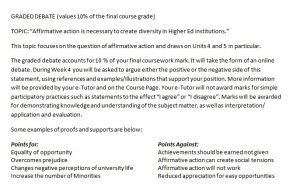A debate is a formal competition between two teams, usually with three members each, arguing a discussion statement known as “the moot”. Shaw (2012) believes that debates stimulate critical thinking and can be a highly effective way to actively engage students in research in the online classroom. Student-generated debate presentations can become a welcome change from the call and response format of the typical online discussion board interactions. Preparation for an online debate begins with identifying appropriate topics, sample references (from course related literature), dates for each debate, and dividing students into teams. Suitably developed moots support students’ interaction and critical thinking and reflection skills and help students to develop their own points of view regarding a topic or course of study. One could debate then, that the format of the online debate can support multiple skills and competencies for the online and distant learning student. The debate in its typical format supports flexibility, reflection, interpersonal and teamwork skill development. The interactivity of this format allows for peer motivation, and the development of communities of learning. These interactions also result in a significant understanding of the course content and the development of knowledge communities among students.
Effective online debate moots create an atmosphere for students to display the visual, auditory, read/write and kinesthetic –VARK– modalities that facilitate the different learning styles preferences and tie in with the multiple intelligences of the individual (Fleming and Baume, 2006). The debate allows the facilitator/ instructor to tap into the different strengths of the learner and can create a platform for successful peer intervention for students who might need this support. Designing Online Debates (2002) provides several categories in which these moots might be placed for ease of access to the neophyte online facilitators:
- Leadership Roles – Useful when students have had limited exposure to varying forms and need exposure to different ideas. This moot allows students to explore what works in particular situations.
- Interpretation of Literature – Is an excellent way to tease out multiple interpretations of texts. They are appropriate only for texts which have clearly defined opposing interpretations, such as portions of the Bible.
- Theory – Good forum for the discussion of differing schools of thought within a discipline. May be very exciting for students to challenge the theoretical conventional wisdom within the structure of formal debate.
- Ethical Considerations – May be the best way to explore ideas without controversy, but students may resent the Devil’s Advocate during this more sensitive subject matter. May be difficult for students to remain objective when topics are emotionally compelling to them.
- Problem Solving – Supportive online environment may encourage creative thought and solutions through exploration of topic. Encourages students to practice problem solving techniques in their coursework.
- Current Events – Allows students to explore many angles of issues in a non-threatening atmosphere and critique of common judgments will help students be precise in defense of their own beliefs. Encourages students to develop compelling arguments about current, relevant topics.
- Political Action – May make students more comfortable expressing “politically incorrect” views. Can create an adversarial atmosphere.
- Changes Within Discipline – Students can theorize different possibilities or outcomes for a course of action and develop their own philosophies regarding possible changes. Students become well versed in the directions their field may take or has taken.
The online debate can take one of two options. Option 1: the debate interactions occur within synchronous course sessions (web-conferencing) where the speakers can be seen and heard by the audience. Option 2: the debate can be conducted on a discussion board following the rules of a typical debate with initial posts and responses in affirmative and negative discussion threads. In option one, the moot would be shared in the newsfeed or as an assignment with the rules clearly outlined for all participants. In option 2 the moot can be displayed on the course page as a discussion topic and the description or rules inserted in the description section of the discussion. For either option, the debate can form a part of the course content and context and be presented as a class assignment within the course schedule.
Below are four tips for creating debate moots and teams:
- Tips 1: Avoid hot–button topics that could prejudice gender, race, religion or ethnicity.
- Tip 2: Word the moot as an interesting affirmative statement that is related to the course content.
- Tip 3: Pre-Select debate teams by including different student types; as much as possible include an equal number of introverts and extroverts on each debate team.
- Tip 4: The moot must be well-structured and should be presented as an affirmative statement.
Link to example artifact(s)
Dr. Florence Gilzene Cheese from the University of the West Indies designed the following online debate activities:
- File:Online Debates – TOPR Artifact 1.docx
- File:REVDEBATEGUIDELINES.docx
- File:GRADED DEBATE RUBRIC.docx
Link to scholarly reference(s)
Shaw, J. A. (2012). Using Small Group Debates to Actively Engage Students in an Introductory Microbiology Course. Journal of Microbiology & Biology Education. http://dx.doi.org/10.1128/jmbe.v13i2.420
Citation
Williams, F. (2015). Use online debates to enhance classroom engagement. In B. Chen & K. Thompson (Eds.), Teaching Online Pedagogical Repository. Orlando, FL: University of Central Florida Center for Distributed Learning. https://topr.online.ucf.edu/use-online-debates-to-enhance-classroom-engagement/.
